Clasp prosthesis on the lower jaw
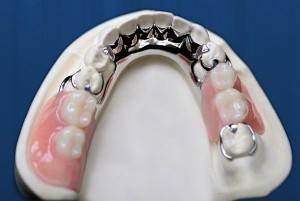
Clasp dentures - designs that allow you to restore the functionality and aesthetics of the dentition.
Clasp prostheses can be installed, both with a partial absence of teeth, and a complete adentia.
The advantages of such prostheses are that the chewing load is as close to physiological as possible.
In the manufacture of structures, maximum attention is paid to the accuracy of measurements and modeling of all elements of the prosthesis.
Clasp prosthesis on the lower jaw consists of:
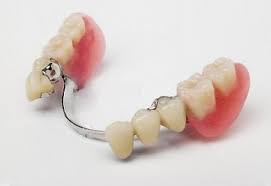
- Metal frame - arches (clasp) and fixing elements. The metal frame of the structure is made of titanium-based alloys. Titanium gives compactness and lightness of design, which allows you to quickly get used to the prosthesis.
- Saddle-shaped part (plastic) with artificial teeth.
Clasp prosthesis arch performs the functions of:
- Supporting.
- Stabilizing.
- Connective.
Its location and size are affected by the anatomy of the jaw and the localization of the defect in the dentition, the depth and shape of the arch of the palate.
When prosthetics of the lower jaw, the arch of the clasp structure is located on the side of the tongue in the middle between the level of the gingival margin and the bottom of the oral cavity.
The arc is made thicker and narrow so that it does not interfere with the freedom of the frenum of the tongue and does not cause painful or unpleasant sensations.
Clasp prosthesis on the lower jaw - one of the options for removable prosthetics. It can be removed and put on by the patient independently. Before going to bed, it is not necessary to remove such a prosthesis.
Fixation
The clasp structure is fixed to the lower jaw using hooks, attachments and telescopic crowns.
Clasp prosthesis on attachments (locks)
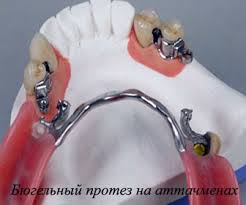
The castle consists of two parts: matrix and patrician. One of them is fixed to the abutment teeth, the other is built into the metal frame of the clasp structure.
They are used if there is a sufficient height of the tooth crowns and in the absence of periodontal diseases.
The advantage of attachments is the lack of their visibility when talking and smiling, the reliability of fixation and durability.
Clasp prosthesis with clasps
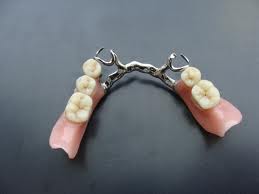
This is the most popular type of removable structure. The clasp covers the abutment.
To do this, there is no need to grind the tooth.
It is used with a pronounced manifestation of the shape of the teeth and dental crowns having a sufficient height.
It is one of the indications for the use of splint construction (a multi-link clasp is added) to strengthen the teeth.
The clasp is visible with a smile and a conversation, which is a minus in terms of aesthetics.
Clasp dentures on telescopic crowns
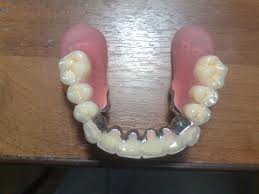
The fixing element in this case is a telescopic crown, which consists of a removable part - is attached to the base of the structure and fixed, attached to the abutment teeth.
It is used in the presence of low clinical crowns of natural teeth and their mild form.
The advantage is the reliability of fastening and higher aesthetics of the design. The disadvantage comes down to turning the teeth.
Indications
The installation of a clasp prosthesis on the lower jaw has indications:
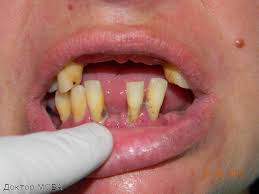
- Multiple defects in the dentition.
- Periodontal disease with defects in the dentition.
- Lack of teeth in front of the dentition.
- The presence of defects in the dentition in the lateral jaw.
- End defects of the dentition.
- Loose teeth.
Contraindications
The installation of a clasp prosthesis on the lower jaw has contraindications:
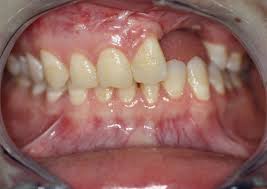
- Inadequate hygiene of the oral cavity.
- State of pregnancy.
- The presence of acute inflammation in the oral cavity.
- The presence of oncology.
- Mental disorders.
- Exacerbation of cardiovascular disease.
- Exacerbation of respiratory diseases.
- The presence of allergies to the metal part of the structure.
- Bone disease.
- Inability to fix to abutment teeth.
- The presence of a deep bite.
- Pronounced atrophic changes in the alveolar processes.
- Intolerance to the removable structure.
- Insufficient depth of the bottom of the oral cavity.
- Addiction, alcoholism.
Advantages
- Low cost.
- Fairly high aesthetics of the design.
- No removal of the structure at night is required.
- The possibility of combining the treatment of periodontal disease, with the restoration and strengthening of teeth.
- Fairly easy maintenance.
- Prevention of gum disease.
Video: “Removable prosthesis”
Reviews
Clasp prosthesis on the lower jaw received reviews from people using the design according to the following relevant criteria: reliability, convenience and comfort, long service life.
- Due to the lack of teeth on the lower jaw, she installed a clasp structure five years ago. Before, there was absolutely nothing to chew. I got used to the design quickly enough. I’m not rubbing anywhere, I can eat almost everything I want, except for solid foods. The prosthesis does not need to be removed before bedtime, which is very convenient.
- I have been suffering from periodontal disease for seven years. She splinted four lower anterior teeth three years ago. I got used to the prosthesis for a long time. The teeth got stronger.
- Two years ago I made a clasp prosthesis. At first, there was severe pain in the gums, after which the taste of metal was felt in the mouth. The dentist said that this is normal, other patients take a long time to get used to such structures. Now everything is fine, only sometimes I feel discomfort.
- In the last three years, the teeth have become very loose and even started to fall out. The dentist suggested installing a splint prosthesis. Now everything is fine, I am calm for my teeth. I got used to the prosthesis for about five months.
- Several teeth on the lower jaw were missing. Four years ago, I installed a clasp structure that replaced my missing teeth. I use the prosthesis with pleasure.
Cost
Clasp prosthesis on the lower jaw, the price of which may vary in different clinical situations, is a fairly inexpensive type of tooth restoration.
The cost also depends on the complexity of the design and the type of fixation. Prosthetics on locks are more expensive than on clasps, as in this case, the cost of crowns and work on the preparation of supporting teeth is taken into account.
| Type of prosthesis | Price in rubles |
| Four crowns on the lower jaw | 50000 |
| One-way clasp prosthesis with locks | 36000 |
| Splint clasp prosthesis on the lower jaw | 40000 |
| Clasp prosthesis on the lower jaw with clasps | 31000 |
Clasp prosthesis on the lower jaw before and after photos
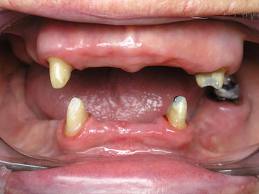 |
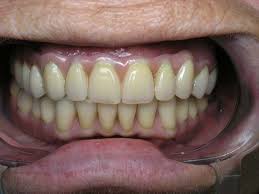 |
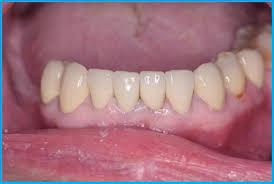 |
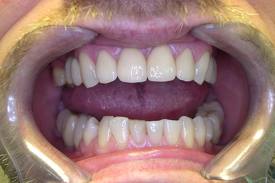 |
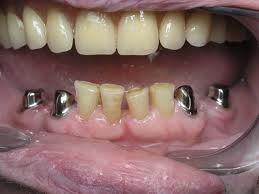 |
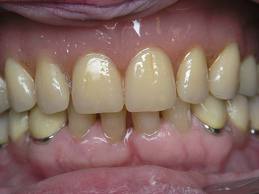 |